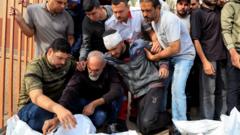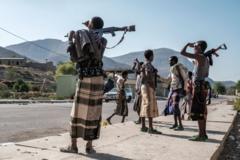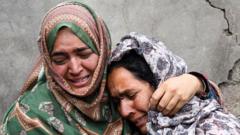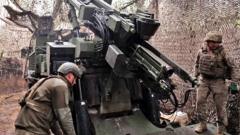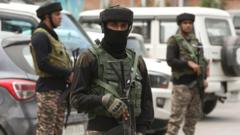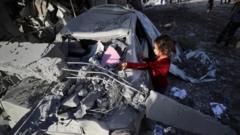In a four-day escalation of conflict between India and Pakistan over Kashmir, civilians on both sides faced devastating consequences. Reports from families affected by the shelling depict the horrors endured and highlight the urgent need for a sustained ceasefire and protection for civilians.
The Fragile Ceasefire: A Haunting Tale from the Indo-Pak Conflict
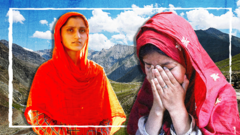
The Fragile Ceasefire: A Haunting Tale from the Indo-Pak Conflict
Eyewitness accounts reflect the turmoil and human cost of the recent violence between India and Pakistan, reminding us of the precarious nature of peace in Kashmir.
In the recent surge of violence between India and Pakistan, families caught in the crossfire have shared heart-wrenching accounts of loss and suffering. The dramatic events escalated following a militant attack in India-administered Kashmir, leading to retaliatory strikes that cascaded into a cycle of shelling and destruction.
Sixteen-year-old Nimra, a resident of Pakistan-administered Kashmir, found herself watching in horror as missiles rained down, unaware that she too had been hit. A piece of shrapnel lodged near her heart changed her life irrevocably in a moment marked by fear and chaos. Meanwhile, in India-administered Poonch, families like that of 72-year-old MN Sudhan faced similar desperation. Sudhan's grandson, caught in the hail of fire, perished almost instantaneously, leaving his family grappling with an unbearable void amidst the unrest.
The violence spanned four harrowing days as both nations engaged in tit-for-tat strikes, claiming military targets while denying civilian casualties, although reports indicate significant losses on both sides. The crescendo of hostilities culminated in missile attacks on military bases, raising fears of a full-blown war. It was only after intervention by international players, especially the United States, that a ceasefire was established, averting a potentially catastrophic escalation.
With at least 56 lives lost and many more injured, residents described their anguish over destroyed homes and lives. The conflict brought back memories of past wars, with some residents mourning the return of violence after a relative period of peace since a ceasefire agreement two years prior. Each family told a story of loss, fear, and resilience, underscoring the urgent need for both governments to prioritize civilian safety in their military strategies.
As communities struggle to comprehend the aftermath, tales of survival emerge from the rubble. Individuals like Sanam, who lost her mother during the attacks, and Shams Ur Rehman, who witnessed the collapse of his life’s work in an instant, call for accountability and safety for innocent civilians. Their stories paint a grim picture of life in one of the world's most militarized regions, highlighting that despite the ceasefire, the shadows of conflict linger on.
To truly honor the lives disrupted by these events, both nations must pursue a path of dialogue and cooperation, ensuring that the voices of civilians resonate louder than the echoes of military conflict.








